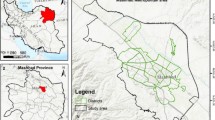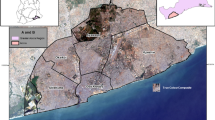Abstract
Spatial information on climatic characteristics is beneficial in e.g. regional planning, building construction and urban ecology. The possibility to spatially predict urban–rural temperatures with statistical techniques and small sample sizes was investigated in Turku, SW Finland. Temperature observations from 36 stationary weather stations over a period of 6 years were used in the analyses. Geographical information system (GIS) data on urban land use, hydrology and topography served as explanatory variables. The utilized statistical techniques were generalized linear model and boosted regression tree method. The results demonstrate that temperature variables can be robustly predicted with relatively small sample sizes (n ≈ 20–40). The variability in the temperature data was explained satisfactorily with few accessible GIS variables. Statistically based spatial modelling provides a cost-efficient approach to predict temperature variables on a regional scale. Spatial modelling may aid also in gaining novel insights into the causes and impacts of temperature variability in extensive urbanized areas.



Similar content being viewed by others
References
Akaike H (1974) A new look at the statistical identification model. IEEE Trans Autom Contr 19:716–723
Alcoforado MJ, Andrade H (2006) Nocturnal urban heat island in Lisbon (Portugal): main features and modelling attempts. Theor Appl Climatol 84:151–159. doi:10.1007/s00704-005-0152-1
Atkinson BW (2003) Numerical modelling of urban heat island intensity. Bound Lay Meteorol 109:285–310. doi:10.1023/A:1025820326672
Balázs B, Unger J, Gál T, Sümeghy Z, Geiger J, Szegedi S (2009) Simulation of the mean urban heat island using 2D surface parameters: empirical modelling, verification and extension. Meteorol Appl 16:275–287. doi:10.1002/met.116
Bottyan Z, Unger J (2003) A multiple linear statistical model for estimating the mean maximum urban heat island. Theor Appl Climatol 75:233–243. doi:10.1007/s00704-003-0735-7
Brown DJ, Shepherd KD, Walsh MG, Mays MD, Reinsch TG (2006) Global soil characterization with VNIR diffuse reflectance spectroscopy. Geoderma 132:273–290. doi:10.1016/j.geoderma.2005.04.025
Burnham KP, Anderson DR (1998) Model selection and inference: a practical information-theoretic approach. Springer, New York
Chapman L, Thornes JE (2003) The use of geographical information systems in climatology and meteorology. Prog Phys Geogr 27:313–330. doi:10.1191/030913303767888464
City of Turku (2001) Turku Master Plan 2020. Environmental and City Planning Office, Turku
City of Turku (2010) Floor area of the buildings. Real Estate Department, Turku
Cleugh HA, Oke TR (1986) Suburban-rural energy balance comparisons in summer for Vancouver, B.C. Bound-Lay Meteorol 36:351–369. doi:10.1007/BF00118337
Conti S, Meli P, Minelli G, Solmini R, Toccaceli V, Vichi M, Beltrano C, Perini L (2005) Epidemologic study of mortality during the summer 2003 heat wave in Italy. Environ Res 98:390–399. doi:10.1016/j.envres.2004.10.009
Cotton WR, Pielke RA (1995) Human impacts on weather and climate. Cambridge University Press, Cambridge
Dobech H, Dumolard P, Dyras I (eds) (2007) Spatial interpolation of climate data. The use of GIS in climatology and meteorology. ISTE, London
Drebs A, Nordlund A, Karlsson P, Helminen J, Rissanen P (2002) Climatological statistics of Finland 1971–2000. Clim Stat Finland 2002:1–99
Ekholm J (1981) Joensuun paikallisilmasto. Terra 93:145–154
Eliasson I, Svensson MK (2003) Spatial air temperature variations and urban land use—a statistical approach. Meteorol Appl 10:135–149. doi:10.1017/S1350482703002056
Elith J, Leathwick J (2009) Species distribution models: ecological explanation and prediction across space and time. Ann Rev Ecol Evol Syst 40:677–697. doi:10.1146/annurev.ecolsys.110308.120159
Elith J, Graham CH, Anderson RP et al (2006) Novel methods improve prediction of species’ distributions from occurrence data. Ecography 29:129–151. doi:10.1111/j.2006.0906-7590.04596.x
Elith J, Leathwick JR, Hastie T (2008) A working guide to boosted regression trees. J Anim Ecol 77:802–813. doi:10.1111/j.1365-2656.2008.01390.x
FMI (2009) Climate service. Telephone customer service. Finnish Meteorological Institute
Friedman J (2002) Stochastic gradient boosting. Comp Stat Data Anal 38:367–378. doi:10.1016/S0167-9473(01)00065-2
Friedman J, Hastie T, Tibshirani R (2000) Additive logistic regression: a statistical view of boosting. Ann Stat 38:337–374. doi:10.1214/aos/1016218223
Giridharan R, Kolokotroni M (2009) Urban heat island characteristics in London during winter. Sol Energy 83:1668–1682. doi:10.1016/j.solener.2009.06.007
Giridharan R, Lau SSY, Ganesan S, Givoni B (2006) Urban design factors influencing urban heat island intensity in high rise high density environments of Hong Kong. Build Environ 42:3669–3684. doi:10.1016/j.buildenv.2006.09.011
Godefroid S, Koedam N (2007) Urban plant species patterns are highly driven by density and function of built-up areas. Landscape Ecol 22:1227–1239. doi:10.1007/s10980-007-9102-x
Hart MA, Sailor DJ (2009) Quantifying the influence of landuse and surface characteristics on spatial variability in the urban heat island. Theor Appl Climatol 95:397–406. doi:10.1007/s00704-008-0017-5
Hastie T, Tibshirani R, Friedman J (2001) The elements of statistical learning: data mining, inference and prediction. Springer, New York
Heisler GM, Brazel AJ (2010) The urban physical environment: temperature and urban heat islands. In: Aitkenhead-Peterson J, Volder A (eds) Urban ecosystem ecology. American Society of Agronomy, Crop Science Society of America, Soil Science, Society of America, Madison, pp 29–56
Hinkel KM, Nelson FE, Klene AE, Bell JH (2003) The urban heat island in winter at Barrow, Alaska. Int J Clim 23:1889–1905. doi:10.1002/joc.971
Hjort J, Marmion M (2008) Effects of sample size on the accuracy of geomorphological models. Geomorph 102:341–350. doi:10.1016/j.geomorph.2008.04.006
Hjort J, Marmion M (2009) Periglacial distribution modelling with a boosting method. Permafr Periglac Process 20:15–25. doi:10.1002/ppp.629
Hjort J, Etzelmüller B, Tolgensbakk J (2010) Effects of scale and data source in periglacial distribution modelling in a High Arctic environment, western Svalbard. Permafr Periglac Process 21:345–354. doi:10.1002/ppp.705
Howard L (1818) Climate of London. Harvey and Darton, London
Johnson DP, Wilson JS (2009) The socio-spatial dynamics of extreme urban heat events: the case of heat-related deaths in Philadelphia. Appl Geogr 29:419–434. doi:10.1016/j.appgeog.2008.11.004
Kent M, Stevens RA, Zhang L (1999) Urban plant ecology patterns and processes:a case study of the flora of the City of Plymouth, Devon, UK. J Biogeogr 26:1281–1298. doi:10.1046/j.1365-2699.1999.00350.x
Kim Y, Baik J (2004) Daily maximum urban heat island intensity in large cities of Korea. Theor Appl Climatol 79:151–164. doi:10.1007/s00704-004-0070-7
Klysik K (1996) Spatial and seasonal distribution of anthropogenic heat emissions in Lodz, Poland. Atmos Environ 30:3397–3404. doi:10.1016/1352-2010(96)00043-X
Klysik K, Fortuniak K (1999) Temporal and spatial characteristics of the urban heat island of Lodz, Poland. Atmos Environ 33:3885–3895. doi:10.1016/S1352-2310(99)00131-4
Landsberg HE (1981) The urban climate. Academic, London
Leathwick JR, Elith J, Francis MP, Hastie T, Taylor P (2006) Variation in demersal fish species richness in the oceans surrounding New Zealand: an analysis using boosted regression trees. Mar Ecol Prog Ser 321:267–281
Luoto M, Hjort J (2006) Scale matters—a multi-resolution study of the determinants of patterned ground activity in subarctic Finland. Geomorph 80:282–294. doi:10.1016/j.geomorph.2006.03.001
Magee N, Curtis J, Wendler G (1999) The urban heat island effect at Fairbanks, Alaska. Theor Appl Climatol 64:39–47. doi:10.1007/s007040050109
Martinaitis V (1998) Analytic calculation of degree-days for the regulated heating season. Energy Build 28(2):185–189
McCullagh P, Nelder JA (1989) Generalized linear models, 2nd edn. Chapman and Hall, London
Meehl GA, Tebaldi C (2004) More intense, more frequent, and longer lasting heat waves in the 21st century. Science 305:994–997. doi:10.1126/science.1098704
Memon RA, Leung DYC, Chunho L (2007) A review on the generation, determination and mitigation of Urban Heat Island. J Environ Sci 20(1):120–128. doi:10.1016/S1001-0742(08)60019-4
Miara K, Paszyfiski J, Grzybowski J (1987) Zrózniicowanie przestrzenne bilansu promieniowania na obszarze Polski. Przegled Geogr. t. LIX, z. 4
Mihalakakou HA, Flocas M, Santamouris HCG (2002) Application of neural networks to the simulation of the heat island over Athens, Greece, using synoptic types as a predictor. J Appl Meteorol 41:519–527. doi:10.1175/1520-0450(2002)041<0519:AONNTT>2.0.CO;2
Mills G (2009) Micro- and mesoclimatology. Prog Phys Geogr 33:711–717. doi:10.1177/0309133309345933
Oke TR (1973) City size and the urban heat island. Atmos Environ 7:769–779. doi:10.1016/0004-6981(73)90140-6
Oke TR (1981) Canyon geometry and the urban heat island: comparison of scale model and field observations. Int J Climatol 1:237–254. doi:10.1002/joc.3370010304
Oke TR (1987) Boundary layer climates, 2nd edn. Routledge, London
Oke TR (2006) Initial guidance to obtain representative meteorological observations at urban sites. Instruments and observing methods report No. 81. World Meteorological Organization, Geneva
Peel MC, Finlayson BM, McMahon TA (2007) Updated world map of the Köppen-Geiger climate classification. Hydrol Earth Syst Sci 11:1633–1644
R Development Core Team (2010) R: a language and environment for statistical computing. R Foundation for Statistical Computing. http://www.R-project.org. Accessed 24 June 2010
Rajasekar U, Weng Q (2009) Urban heat island monitoring and analysis using a non-parametric model: a case study of Indianapolis. ISPRS J Photogramm Remote Sens 64:86–96. doi:10.1016/j.isprsjprs.2008.05.002
Ridgeway G (2007) Generalized boosted regression models. Documentation on the R Package ‘gbm’, version 1.6–3. http://cran.r-project.org/web/packages/gbm/gbm.pdf. Accessed 24 June 2010
Seinä A, Peltola J (1991) Duration of the ice season and statistics of fast ice thickness along the Finnish coast 1961–1990. Finn Mar Res 258:1–46
Seinä A, Eriksson P, Kalliosaari S, Vainio J (2006) Ice seasons 2001–2005 in Finnish sea areas. Rep Ser Finn Inst Mar Res 57:1–94
SLICES (2010) National Land Survey of Finland. http://www.slices.nls.fi/. Accessed 13 June 2010
Sokal RR, Rohlf F (1995) Biometry. WH Freeman, New York
Steinecke K (1999) Urban climatological studies in Reykjavik surbarctic environment, Iceland. Atmos Environ 33:4157–4162. doi:10.1016/S1352-2310(99)00158-2
Stockwell DRB, Peterson AT (2002) Effects of sample size on accuracy of species distribution models. Ecol Mod 148:1–13. doi:10.1016/S0304-3800(01)00388-X
Sundborg Å (1950) Local climatological studies of the temperature conditions in an urban area. Tellus 2:222–232. doi:10.1111/j.2153-3490.1950.tb00333.x
Suomi J, Käyhkö J (2011) The impact of environmental factors on urban temperature variability in the coastal city of Turku SW Finland. Int J Climatol. doi:10.1002/joc.227
Svensson MK, Eliasson I (2002) Diurnal air temperatures in built-up areas in relation to urban planning. Landscape Urban Plan 61:37–54. doi:10.1016/S0169-2046(02)00076-2
Svensson M, Eliasson I, Holmer B (2002) A GIS based empirical model to simulate air temperature variations in the Göteborg urban area during the night. Clim Res 22:215–226
Szymanowski M, Kryza M (2009) GIS-based techniques for urban heat island spatialization. Clim Res 38:171–187
Taha H (1997) Urban climates and heat islands: albedo, evapotranspiration, and anthropogenic heat. Energy Build 25:99–103. doi:10.1016/S0378-7788(96)00999-1
Tan J, Zheng Y, Tang X, Guo C, Li L, Song G, Zhen X, Yuan D, Kalkstein AL, Li F, Chen H (2010) The urban heat island and its impact on heat waves and human health in Shanghai. Int J Biometeorol 54:75–84. doi:10.1007/s00484-009-0256-x
Unger J, Sümeghy Z, Gulyás Á, Bottyán Z, Mucsi L (2001) Land-use and meteorological aspects of the urban heat island. Meteorol Appl 8:189–194. doi:10.1017/S1350482701002067
Vicente-Serrano SM, Lanjeri S, López-Moreno JI (2007) Comparison of different procedures to map reference evapotranspiration using geographical information systems and regression-based techniques. Int J Climatol 27:1103–1118. doi:10.1002/joc.1460
Vicente-Serrano SM, López-Moreno JI, Vega-Rodríguez MI, Beguería S, Cuadrat JM (2010) Comparison of regression techniques for mapping fog frequency: application to the Aragón region (northeast Spain). Int J Climatol 30:935–945. doi:10.1002/joc.1935
Zimmermann NE, Edwards TC, Moisen GG, Frescino TS, Blackard JA (2007) Remote sensing-based predictors improve distribution models of rare, early successional and broadleaf tree species in Utah. J Appl Ecol 44:1057–1067. doi:10.1111/j.1365-2664.2007.01348.x
Acknowledgements
We express our gratitude to three anonymous reviewers for the critical and helpful comments which improved the manuscript. JS was funded by the Finnish Cultural Foundation’s Varsinais-Suomi Regional Fund and the Emil Aaltonen Foundation. TURCLIM project is maintained in collaboration with the Turku Environmental and City Planning Department, whose assistance is greatly acknowledged. The long-term reference weather data used in this study is provided by the Finnish Meteorological Institute.
Author information
Authors and Affiliations
Corresponding author
Rights and permissions
About this article
Cite this article
Hjort, J., Suomi, J. & Käyhkö, J. Spatial prediction of urban–rural temperatures using statistical methods. Theor Appl Climatol 106, 139–152 (2011). https://doi.org/10.1007/s00704-011-0425-9
Received:
Accepted:
Published:
Issue Date:
DOI: https://doi.org/10.1007/s00704-011-0425-9




